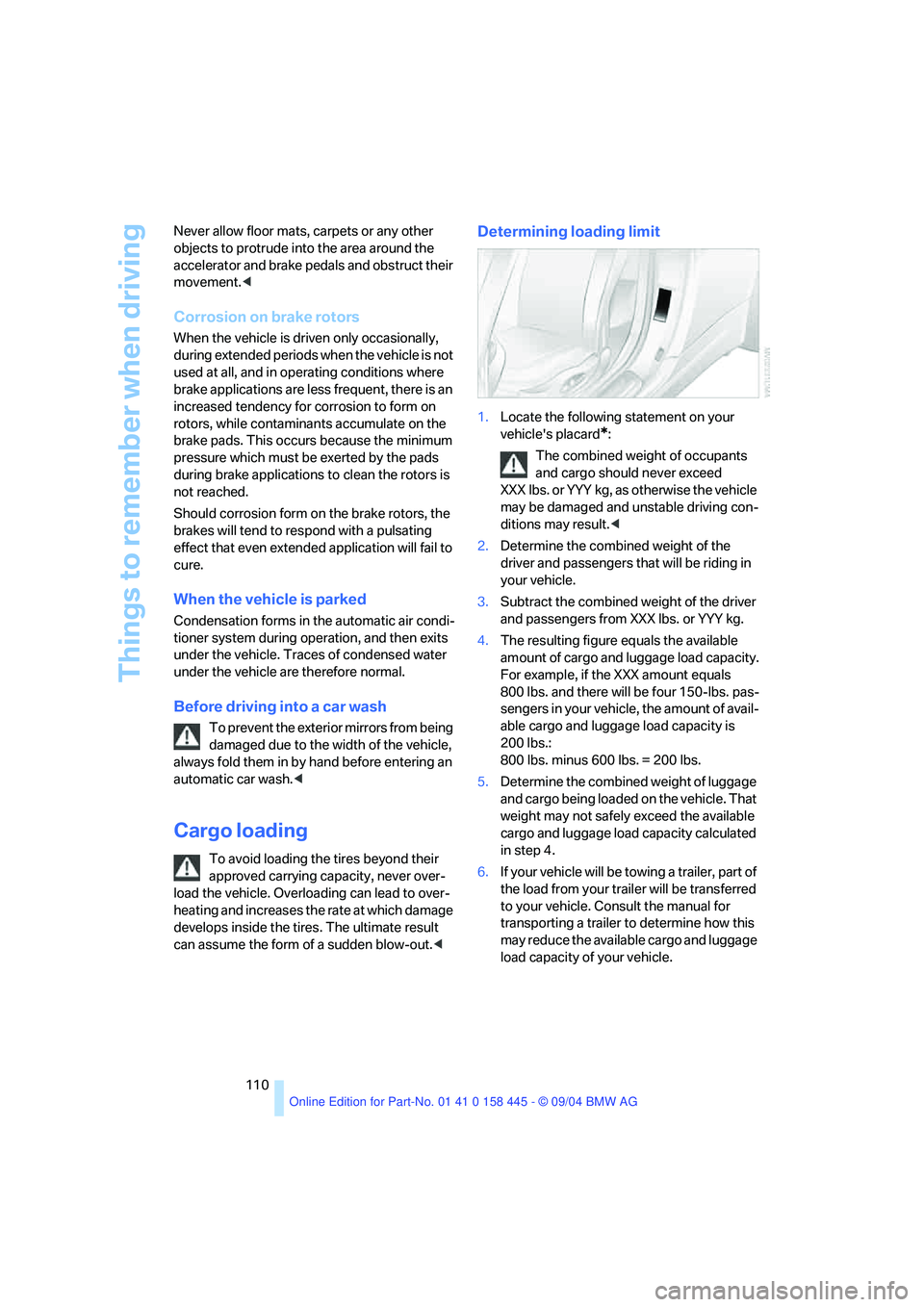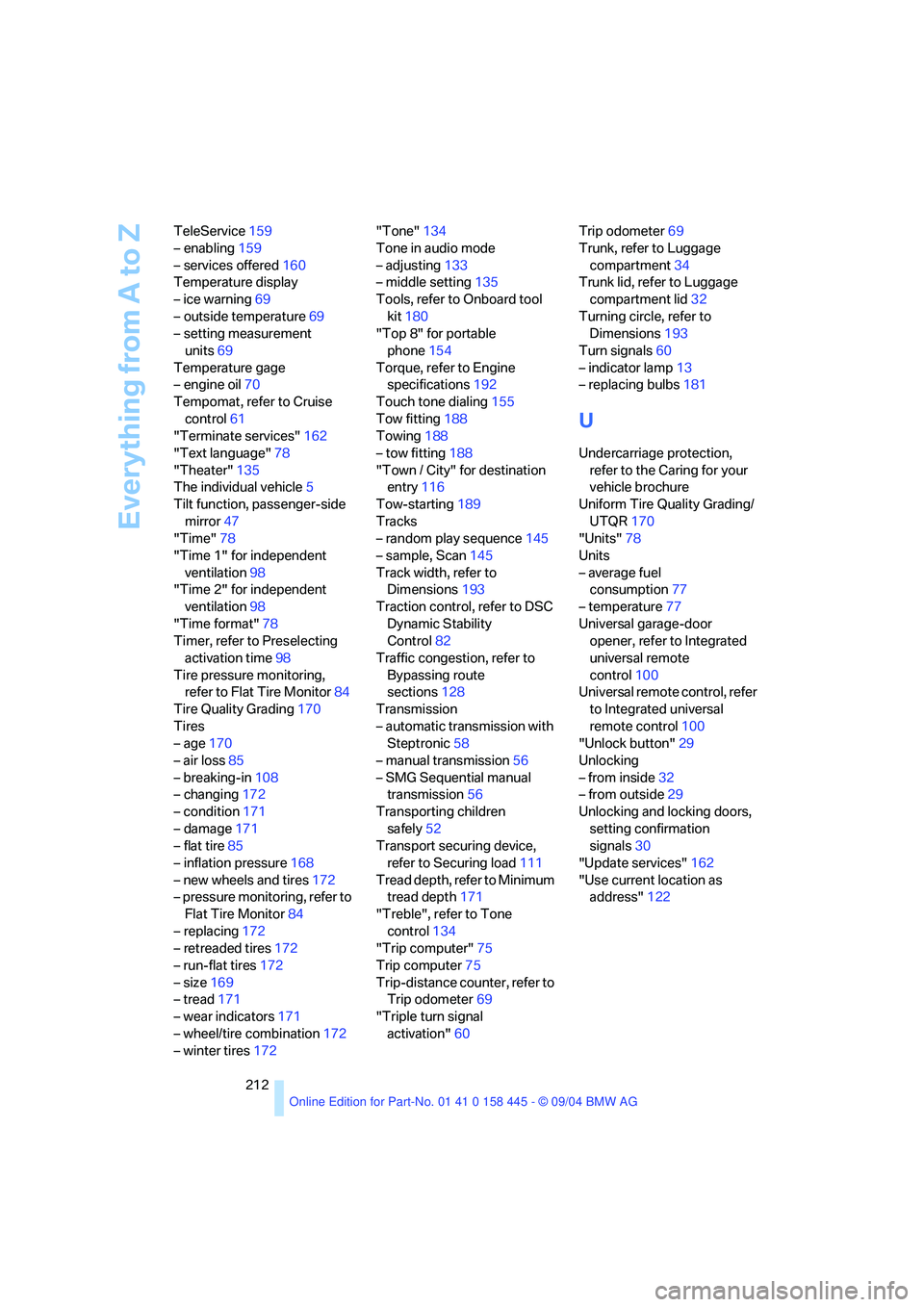2005 BMW 645CI COUPE&CONVERTIBLE width
[x] Cancel search: widthPage 51 of 217

Adjustments
50 1Adjustments
2Switching over to the respective other mir-
ror or to the automatic parking function,
refer to Tilting down passenger's mirror,
page47
Storing the mirror positions, refer to Seat, mir-
ror and steering wheel memory, page46.
Adjusting manually
You can also adjust the mirrors manually if
necessary by pressing against the edges of
the mirror glass.
Outside mirrors, folding in and out
To prevent the exterior mirrors from being
damaged due to the width of the vehicle,
always fold them in by hand before entering an
automatic car wash.<
Automatic functions
>Both exterior mirrors are automatically
heated in ignition key position 2.
>When the vehicle is moving forward, the
interior and exterior mirrors dim as a func-
tion of the incoming light
*.
There are two photocells in the interior mirror to
control the automatic dimming of the interior mirror. One is integrated into the mirror glass,
refer to arrow, while the other is located at a
position slightly offset from this on the rear of
the mirror housing.
For trouble-free operation, keep the photocells
clean and do not cover the area between the
interior rearview mirror and the windshield. Also
do not attach stickers to the windshield in front
of the mirror.
Steering wheel
Adjustments
Do not adjust the steering wheel while the
vehicle is moving. There is a risk of acci-
dent from unexpected movement of the steer-
ing wheel.<
The steering wheel can be adjusted in four
directions.
Storing the steering-wheel position, refer to
Seat, mirror and steering wheel memory,
page46.
Easy entry/exit
To make it easier to enter and exit the vehicle,
the steering wheel temporarily moves into the
uppermost position.
Page 111 of 217

Things to remember when driving
110 Never allow floor mats, carpets or any other
objects to protrude into the area around the
accelerator and brake pedals and obstruct their
movement.<
Corrosion on brake rotors
When the vehicle is driven only occasionally,
during extended periods when the vehicle is not
used at all, and in operating conditions where
brake applications are less frequent, there is an
increased tendency for corrosion to form on
rotors, while contaminants accumulate on the
brake pads. This occurs because the minimum
pressure which must be exerted by the pads
during brake applications to clean the rotors is
not reached.
Should corrosion form on the brake rotors, the
brakes will tend to respond with a pulsating
effect that even extended application will fail to
cure.
When the vehicle is parked
Condensation forms in the automatic air condi-
tioner system during operation, and then exits
under the vehicle. Traces of condensed water
under the vehicle are therefore normal.
Before driving into a car wash
To prevent the exterior mirrors from being
damaged due to the width of the vehicle,
always fold them in by hand before entering an
automatic car wash.<
Cargo loading
To avoid loading the tires beyond their
approved carrying capacity, never over-
load the vehicle. Overloading can lead to over-
heating and increases the rate at which damage
develops inside the tires. The ultimate result
can assume the form of a sudden blow-out.<
Determining loading limit
1.Locate the following statement on your
vehicle's placard
*:
The combined weight of occupants
and cargo should never exceed
XXX lbs. or YYY kg, as otherwise the vehicle
may be damaged and unstable driving con-
ditions may result.<
2.Determine the combined weight of the
driver and passengers that will be riding in
your vehicle.
3.Subtract the combined weight of the driver
and passengers from XXX lbs. or YYY kg.
4.The resulting figure equals the available
amount of cargo and luggage load capacity.
For example, if the XXX amount equals
800 lbs. and there will be four 150-lbs. pas-
sengers in your vehicle, the amount of avail-
able cargo and luggage load capacity is
200 lbs.:
800 lbs. minus 600 lbs. = 200 lbs.
5.Determine the combined weight of luggage
and cargo being loaded on the vehicle. That
weight may not safely exceed the available
cargo and luggage load capacity calculated
in step 4.
6.If your vehicle will be towing a trailer, part of
the load from your trailer will be transferred
to your vehicle. Consult the manual for
transporting a trailer to determine how this
may reduce the available cargo and luggage
load capacity of your vehicle.
Page 171 of 217

Wheels and tires
170
Tire identification marks
Knowledge of the labeling on the side of the tire
makes it easier to identify and choose the right
tires.
Tire size
Speed letter
T = up to 118 mph/190 km/h
H = up to 131 mph/210 km/h
V = up to 150 mph/240 km/h
W = up to 167 mph/270 km/h
Y = up to 186 mph/300 km/h
Tire Identification Number
Tires with DOT codes meet the guidelines of
the U.S. Department of Transport.
DOT code:
Tire age
The tire's date of manufacture is indicated on
the sidewall:
DOT ... 3604 indicates that a tire was manufac-
tured in week 36 of the year 2004.
BMW recommends replacing all tires at least
every 6 years, even if some tires may last for
10 years.
Uniform Tire Quality Grading
Quality grades can be found where applicable
on the tire sidewall between tread shoulder and
maximum section width. For example:
Tread wear 200 Traction AA
Temperature A
DOT Quality Grades
Tread wear
Traction AA A B C
Temperature A B C
All passenger car tires must conform to
Federal Safety Requirements in addition
to these grades.<
Tread wear
The tread wear grade is a comparative rating
based on the wear rate of the tire when tested
under controlled conditions on a specified gov-
ernment test course.
For example, a tire graded 150 would wear one
and one-half, 1γ, times as well on the govern-
ment course as a tire graded 100. The relative
performance of tires depends upon the actual
conditions of their use, however, and may
depart significantly from the norm due to varia-
tions in driving habits, service practices and dif-
ferences in road characteristics and climate.
Traction
The traction grades, from highest to lowest, are
AA, A, B, and C.
Those grades represent the tire's ability to stop
on wet pavement as measured under controlled
conditions on specified government test sur-
faces of asphalt and concrete. A tire marked C
may have poor traction performance.
The traction grade assigned to this tire is
based on straight-ahead braking traction
tests, and does not include acceleration, cor-
nering, hydroplaning, or peak traction charac-
teristics.<
Temperature
The temperature grades are A, the highest, B,
and C, representing the tire's resistance to the
generation of heat and its ability to dissipate e.g.
Nominal width
in mm
Aspect ratio in Ξ
Radial type
Rim diameter in inches
Load rating
not on ZR tires
Speed rating
before R on ZR tires
205/60 R 15 91 W
e.g.
Manufacturer code
for tire make
Tire size and tire design
Tire ageDOT xxxx xxx 3604
Page 213 of 217

Everything from A to Z
212 TeleService159
– enabling159
– services offered160
Temperature display
– ice warning69
– outside temperature69
– setting measurement
units69
Temperature gage
– engine oil70
Tempomat, refer to Cruise
control61
"Terminate services"162
"Text language"78
"Theater"135
The individual vehicle5
Tilt function, passenger-side
mirror47
"Time"78
"Time 1" for independent
ventilation98
"Time 2" for independent
ventilation98
"Time format"78
Timer, refer to Preselecting
activation time98
Tire pressure monitoring,
refer to Flat Tire Monitor84
Tire Quality Grading170
Tires
– age170
– air loss85
– breaking-in108
– changing172
– condition171
– damage171
– flat tire85
– inflation pressure168
– new wheels and tires172
– pressure monitoring, refer to
Flat Tire Monitor84
– replacing172
– retreaded tires172
– run-flat tires172
– size169
– tread171
– wear indicators171
– wheel/tire combination172
– winter tires172"Tone"134
Tone in audio mode
– adjusting133
– middle setting135
Tools, refer to Onboard tool
kit180
"Top 8" for portable
phone154
Torque, refer to Engine
specifications192
Touch tone dialing155
Tow fitting188
Towing188
– tow fitting188
"Town / City" for destination
entry116
Tow-starting189
Tracks
– random play sequence145
– sample, Scan145
Track width, refer to
Dimensions193
Traction control, refer to DSC
Dynamic Stability
Control82
Traffic congestion, refer to
Bypassing route
sections128
Transmission
– automatic transmission with
Steptronic58
– manual transmission56
– SMG Sequential manual
transmission56
Transporting children
safely52
Transport securing device,
refer to Securing load111
Tread depth, refer to Minimum
tread depth171
"Treble", refer to Tone
control134
"Trip computer"75
Trip computer75
Trip-distance counter, refer to
Trip odometer69
"Triple turn signal
activation"60Trip odometer69
Trunk, refer to Luggage
compartment34
Trunk lid, refer to Luggage
compartment lid32
Turning circle, refer to
Dimensions193
Turn signals60
– indicator lamp13
– replacing bulbs181
U
Undercarriage protection,
refer to the Caring for your
vehicle brochure
Uniform Tire Quality Grading/
UTQR170
"Units"78
Units
– average fuel
consumption77
– temperature77
Universal garage-door
opener, refer to Integrated
universal remote
control100
Universal remote control, refer
to Integrated universal
remote control100
"Unlock button"29
Unlocking
– from inside32
– from outside29
Unlocking and locking doors,
setting confirmation
signals30
"Update services"162
"Use current location as
address"122
Page 214 of 217

Reference 213
At a glance
Controls
Driving tips
Communications
Navigation
Entertainment
Mobility
V
Vehicle
– battery183
– breaking-in108
– care, refer to the Caring for
your vehicle brochure
– cargo loading110
– decommissioning, refer to
the Caring for your vehicle
brochure
– dimensions193
– parking55
– washing, refer to the Caring
for your vehicle brochure
– weights192
Vehicle jack183
– jacking points183
Vehicle position, refer to
Displaying current
position125
"Vehicle settings"29
Ventilating
– independent ventilation98
– refer to Ventilation97
Ventilation97
– draft-free97
Vent outlets of automatic
climate control94
Voice command system22
– short commands196
Voice instructions for
navigation system126
– muting51
– repeating51,126
– switching on/off51,126
– volume126
Voice phone book157
Volume132
– audio sources132
– portable phone151,157
– setting speed-
dependent134
– voice instructions126
Volume adjustment in audio
mode, front-to-rear134
W
Warning lamps, refer to
Indicator/warning lamps13
Warning messages, refer to
Check Control71
Warning triangle186
Warranty and Service Guide
Booklet for Canadian
models178
Washer fluid
– capacity of the reservoir61
– wiper system61
Washer fluid reservoir61
Water on roads, refer to
Driving through water109
Waveband136
"WB"133,139
Wear indicators in tires, refer
to Minimum tread depth171
Weights192
Wheel/tire combination, refer
to New wheels and tires172
Wheel/tire replacement, refer
to New wheels and tires172
Wheelbase, refer to
Dimensions193
Wheels and tires168
Width, refer to
Dimensions193
Wind deflector42
Windows35
– convenience
operation30,31
– opening and closing,
Convertible36
– opening and closing,
Coupe36
– rear window, Convertible37
Windshield washer nozzles61
Windshield washer system,
refer to Washer/wiper
system61
Windshield wiper blade
replacement180
Windshield wipers, refer to
Wiper/washer system60Winter tires172
– setting speed limit76
– storage173
Wiper blade replacement180
Wiper system60
– washer fluid61
– windshield washer
nozzles61
"With highways" for
navigation122
Word matching principle for
navigation123
Working in the engine
compartment174
Wrenches/screwdrivers, refer
to Onboard tool kit180
X
Xenon lamps180
– replacing bulbs180